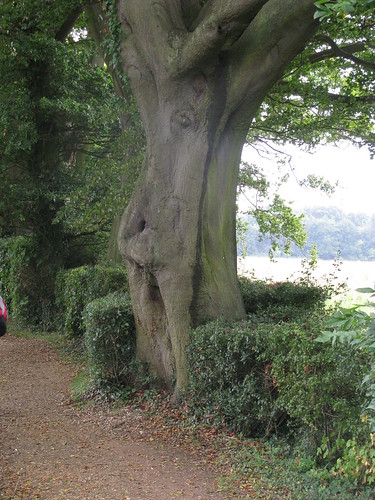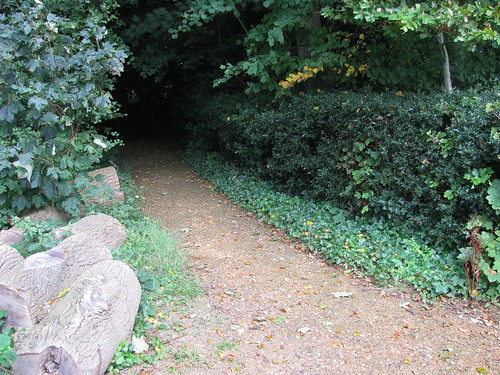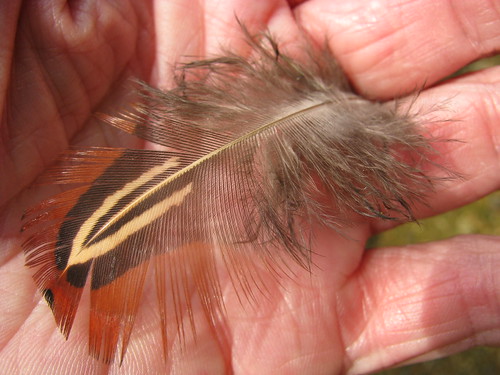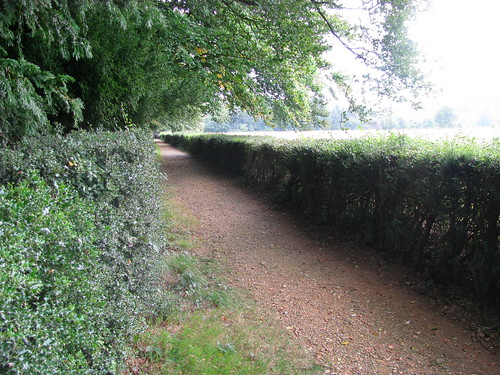tags: Sandwalk, Down House, Darwin, nature, photography, London, England, Bromley, England
Part of The Sandwalk, which is located on the periphery of a large parcel of land that is occupied by Darwin's Down House and associated grounds comprised of flower gardens, food plant gardens, and a greenhouse. I liked the mysterious look of this portion of the Sandwalk, so I photographed it to share with you.
Sunday, the day after the Nature Network Science Blog conference was over, Mike, Mo and I caught a train to Bromley, England, where we toured Darwin's Down House and Gardens and walked along the famous Sandwalk that Darwin once walked. This is the fourth, and last, of my photoessay series about Down House, where I focus on the famous Sandwalk behind the house.
We left the greenhouse and its population of gorgerous plants, reluctantly, and followed the path as it led us past the last part of Darwin's gardens (visible on the left in the image below). We stopped often to admire and photograph various plants along the way, as you saw in the previous photoessay.
The pathway leading away from Down House, Darwin's greenhouse and gardens. This pathway is famously known as "The Sandwalk" where Darwin spent many hours strolling and contemplating his ideas.
After we left main area that was bounded by the tall brick fence, we found ourselves walking alongside an open pasture, where Darwin grazed a couple horses. On the other side of this pathway was a thick hedge and there was a larger pasture beyond. Looking at the countryside, it was easy for me to imagine how fox hunting and steeplechasing got its start.
After we left main area that was bounded by the tall brick fence, we found ourselves walking alongside an open pasture, where Darwin grazed a couple horses.
I really loved this beautiful old tree, so I snapped a second picture of it from the other side. I wonder if it was alive when Darwin strode this pathway? Did it perhaps give him shade on hot days, and relief from the rain during storms?
This is the other side of the large old tree in the previous image. Do you suppose this tree was alive when Darwin walked this pathway? Do you suppose that Darwin might have rested in its shade on a hot day?
As I walked along this pathway, I became mystified as to why it is called "The Sandwalk" since it was not at all sandy, and was actually quite slippery to walk upon. How did it get its name? Was it once sandy, until millions of people walked upon it, crushing the sand into powder that the winds then blew away?
A close look at The Sandwalk reveals that it is not sandy at all. How did it get its name, then?
Along the way, I snapped a few photographs of plantlife growing along the pathway, just to give you an idea of what Darwin might have seen and contemplated during his daily walks.
One part of the pathway was especially beautiful -- which is saying a lot, I know, since the entire Sandwalk is filled with a variety of beautiful life forms. This was a glade that was covered with a dense layer of tree branches, vines and other plantlife. I showed you a picture of this place earlier, but had to show it to you again, just so you can tell me which "works" better in your eye?
After walking through a small, thickly forested area, the Sandwalk emerged into sunlight. Here's a look at where we came from. It looks quite mysterious, doesn't it?
I also found a beautiful feather along the pathway. I think I know the species this came from, but I'll give you the chance to identify the species before I tell you what I think.
Despite the fact that I showed you a lot of the Sandwalk that was in a dense thicket, much of The Sandwalk was actually brightly lit, and bounded on one side by a hedge and on the other side by either a thicket or a pasture fence.
This concludes my photoessays detailing my visit to Darwin's Down House. If you missed the previous Down House photoessays, here is Part Three. Tomorrow, I will show you photoessays of other wonders I saw while in London, so stay tuned!
- Log in to post comments











I hope you don't mind that I "borrowed" your pictures for Sandwalk. They would have been much better with you in them.
I have really enjoyed this photo tour through the grounds at Darwin's home. I always find that I connect much more with the practical gardens of the average citizen than the grand formal designs of the elite. Darwin's garden showed me how he ate, where he relaxed, where he went to work.
If anyone ever has the chance to be in Paris, a short car ride will get you to Monet's garden at Giverny where he painted many of his most famous paintings. It is another classic example of a simple, yet incredibly imaginative garden.
Great series of photos and your experiences while there!
As I understand it, Darwin did at one time have a load of sand brought in to cover the surface of the path - I guess the name just stuck long after it had worn away. The native soil of the region certainly isn't sandy.
If I had to guess at the age of that tree (I'm no expert) I'd place it at somewhere between just over 100 to just over 200 years, so Darwin may well have known it - indeed he may well have planted it, as despite the wild look of that end of the property, the Darwins did do quite a bit of planting there (just in a much more naturalistic style to the main garden, using native wild plants).
I'm not at all certain on the feather, but my first impulse would be pheasant, although I can imagine how it could be several other birds.
I loved this essay. Still it would have been a hoot to have Professor Steve Steve in another of the episodes. In fact I think the team of the good if sometimes petulant professor and yourself are the catalyst for a wonderful children's book.
Bob - there are still the photos of Prof. Steve Steve in the gents at the Geological Society to come. But perhaps not in a children's book.
I seem to remember that Mike slipped and fell on his ass as we walked along the path!